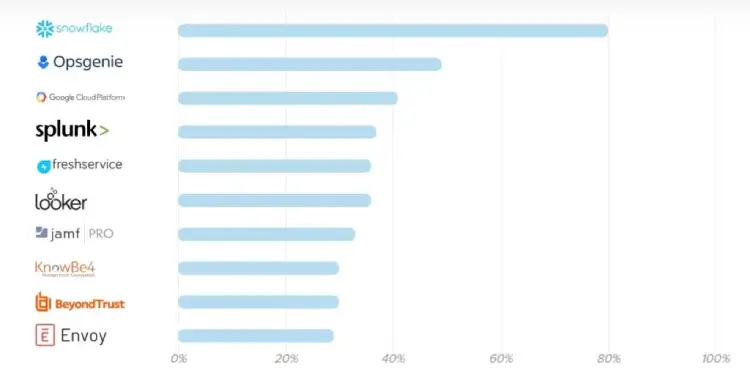
Data management tools have rocketed to the top of the most-used applications by businesses, a new survey reveals.
The annual survey by Okta taps its 7,400 customers and 6,500-strong app and cloud integration network to identify which applications are hottest in the enterprise – revealing some surprises.
Hottest: Snowflake
The fastest growing application used by Okta’s customers is cloud-based data management application Snowflake: the data wrangling platform soared 273 percent year-over-year in 2019.
The US-based firm is hot property with investors too: this morning revealing a new $479 million series G funding round, which was co-led by Salesforce Ventures, raising its valuation to over $12.4 billion.
Snowflake’s 3,400 customers include Sainsburys, which is using it heavily to build a 360 degree view of customer data.

Ming Wu, vice president of data and analytics at Okta, said: “The rapid rise of Snowflake, along with the acquisitions of Looker and Tableau, highlights the growing popularity and importance of data applications in the enterprise. AI and machine learning have helped drive this growth, but we’re also seeing trends in data cataloguing, sharing, democratisation and compliance.
He added: “In the case of Snowflake in particular, the rise of the ‘cloud data warehouse’ is driving a major shift around all things data. Traditionally, data infrastructure has been treated as exactly that – infrastructure. Tightly controlled, behind firewalls or VPNs, where getting to data has been constrained by a number of technical roadblocks.
“With the rise of the cloud data warehouse, accessing data is now easier than ever. With the proliferation of SaaS applications and ELT vendors, the process for getting data from your SaaS applications into the data warehouse for analysis is simpler than ever, and data visualisation tools make it easier for everyone to make sense of that data.”
Other data-focussed apps such as Atlassian, Envoy, Looker, and Splunk also saw a rapid increase in popularity, with Atlassian’s incident management platform Opsgenie the second-fastest growing.
Double-Dipping
Ten percent of Okta’s customers now use a whopping 200 or more apps to power “productive, secure collaboration” – many of them overlapping in terms of functionality: 78 percent of Okta’s Office 365 users are using a “best-of-breed” app with the same functionality as Office, for example.
“When it comes to the trade-off between a centralised provider and individual solutions, functionality, ease of use, and employee needs come first”, Okta’s CEO Todd McKinnon said, explaining the trend.
He added: “Security stacks are also an increasing priority, with Envoy and KnowBe4 leading the pack. When it came to popularity, developer tools made the biggest waves this year — Atlassian Product Suite jumped to fifth place on the most popular apps list, Github joined the ranks at #13, and Lucidchart earned a spot on the list for the first time.”
With attackers increasingly targeting individuals and their credentials to gain unauthorised access to accounts, the protection of people is increasingly at the center of security teams’ strategy, the report notes.
“More than 42 percent of companies now deploy a tool in the people layer, an increase from only 24 percent three years ago. And when customers adopt their first security tool, more than one third start with a tool focused on protecting their people, as opposed to devices, infrastructure, and network. Considering these numbers, it’s no surprise that KnowBe4 and Mimecast — tools focused on securing email against phishing attacks — made the most-adopted security tools list,” said McKinnon.






